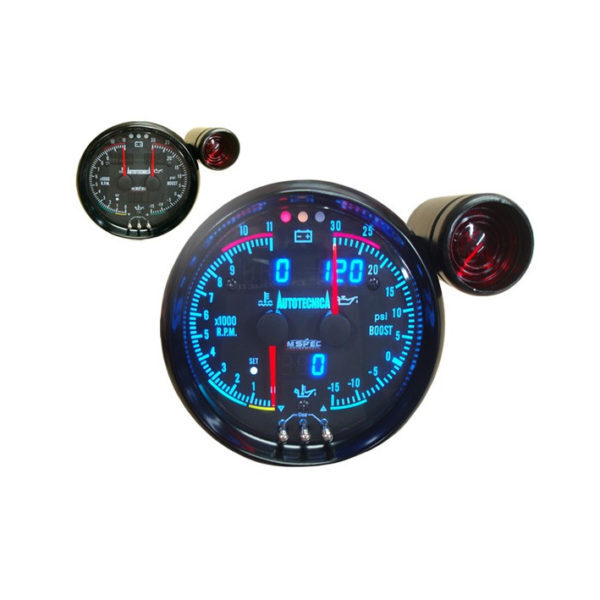Professional Tips for Preserving and Adjusting Your Tachometer
Wiki Article
The Significance of a Tachometer in Keeping An Eye On Engine Speed and Efficiency in Automotive Applications
In the world of automotive engineering, the tachometer stands as an essential tool in the vehicle driver's arsenal, giving a direct window into the inner workings of a car's engine. Beyond its function as a simple scale of changes per min (RPM), the tachometer offers as a critical device for fanatics and specialists alike, offering real-time insights into engine efficiency and wellness.Relevance of Monitoring Engine RPM
Monitoring engine RPM, or revolutions per min, is a crucial aspect of automotive upkeep and efficiency examination. Engine RPM directly correlates with the speed at which the engine's crankshaft rotates, showing just how swiftly the engine is running - tachometer. By keeping an eye on RPM, auto mechanics can evaluate the health of the engine, detect potential concerns, and fine-tune efficiency. An irregular RPM reading might signify issues such as engine misfires, malfunctioning ignition system, or issues with the gas distribution system. Regularly high RPM readings can suggest hostile driving behaviors or the need for a greater gear change to enhance fuel performance.Moreover, keeping track of engine RPM is vital for efficiency evaluation in racing and high-performance automobiles. In recap, monitoring engine RPM is not only crucial for spotting problems yet also for optimizing engine performance in different vehicle applications.

Benefits of Real-Time Information
In auto applications, real-time information plays a crucial role in providing immediate understandings right into the efficiency and condition of the automobile. By constantly keeping an eye on different specifications such as engine rate, temperature level, gas usage, and a lot more, real-time data provides various benefits that contribute to enhanced efficiency and safety and security when driving.
Additionally, real-time information helps with efficiency optimization by offering prompt comments on driving practices and engine performance. Chauffeurs can readjust their habits in real-time based on this details to accomplish far better fuel economic situation and extend the life expectancy of their automobile.

Additionally, real-time data plays an essential duty in contemporary automotive diagnostics, making it possible for technicians to promptly diagnose and attend to malfunctions. This results in minimized downtime, lower maintenance expenses, and inevitably, improved general lorry dependability and long life (tachometer). By utilizing the power of real-time information, auto stakeholders can make informed decisions that favorably influence both the efficiency and longevity of the automobile
Effect On Gear Shifts
Effective gear changes in vehicle applications significantly influence total efficiency and driving experience. The tachometer plays a crucial role in enhancing gear shifts by supplying real-time engine rate data to the motorist. When coming close to the redline on the tachometer, it signifies the vehicle driver to upshift to prevent over-revving the engine and causing potential damage. On the other hand, downshifting at the appropriate minute can aid keep the engine in its power Visit Website band, making certain receptive velocity when required.Furthermore, the tachometer aids in achieving smoother gear changes, specifically in hands-on transmissions. By keeping an eye on engine speed, chauffeurs can execute gear changes at the optimum RPM variety, decreasing jerking activities and lessening wear on the transmission components. This precision in equipment adjustments not only enhances driving convenience however also adds to sustain effectiveness.
Enhancing Fuel Performance
Provided the crucial role the tachometer plays in maximizing gear changes for performance and engine health, it straight adds to optimizing fuel performance in automobile applications. By providing real-time responses on engine speed, the tachometer aids chauffeurs a knockout post in keeping the most reliable RPM variety for gas economic climate. When chauffeurs regularly monitor the tachometer and change their driving routines accordingly, they can prevent unneeded fuel intake triggered by over-revving or lugging the engine.Additionally, the tachometer helps motorists recognize the most fuel-efficient equipment to be in at any kind of given moment, protecting against the engine from working tougher than necessary. This is especially crucial during velocity and travelling, where being in the ideal equipment can significantly affect gas efficiency. Additionally, the tachometer can inform vehicle drivers to possible mechanical issues that might be negatively impacting gas economic situation, such as a slipping clutch or a clogged up air filter. In verdict, the tachometer offers as a valuable tool in improving gas performance by advertising optimum driving habits and visite site determining locations for enhancement in the lorry's efficiency.

Maximizing Engine Long Life
The tachometer's duty in checking engine rate and performance is critical in guaranteeing the longevity of auto engines. By making use of the tachometer successfully, chauffeurs can optimize engine long life with mindful RPM management. Continually revving an engine too expensive can result in too much deterioration on vital components, such as the pistons, shutoffs, and bearings. In time, this can result in lowered engine performance and possible malfunctions. Monitoring the tachometer permits chauffeurs to remain within the suggested RPM range for their vehicle, stopping unnecessary pressure on the engine and extending its life-span.
Final Thought
In conclusion, the tachometer plays a critical role in checking engine speed and efficiency in automobile applications. By giving real-time data on RPM, it permits effective equipment shifts, improved gas effectiveness, and made the most of engine long life. This tool is necessary for maintaining ideal engine efficiency and ensuring the general performance of a vehicle.Report this wiki page